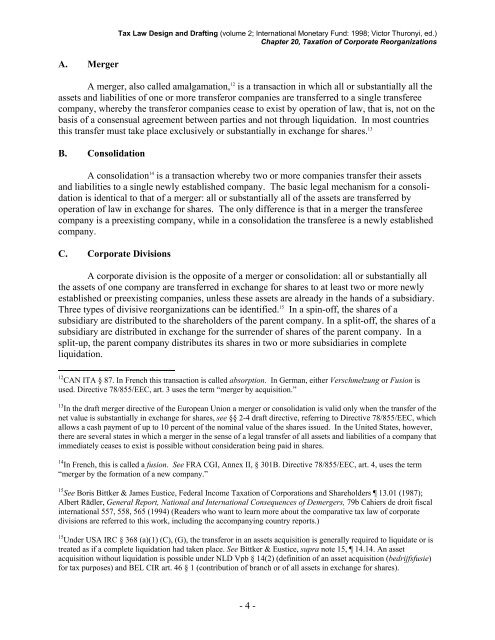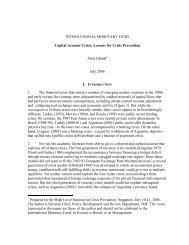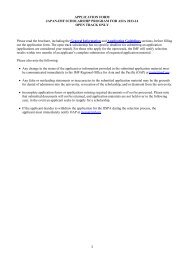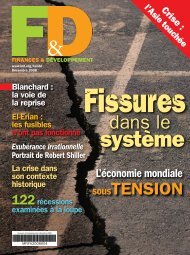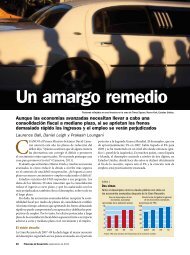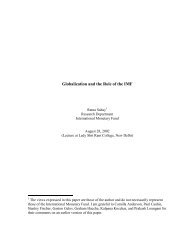Chapter 20: Taxation of Corporate Reorganizations - IMF
Chapter 20: Taxation of Corporate Reorganizations - IMF
Chapter 20: Taxation of Corporate Reorganizations - IMF
You also want an ePaper? Increase the reach of your titles
YUMPU automatically turns print PDFs into web optimized ePapers that Google loves.
A. Merger<br />
Tax Law Design and Drafting (volume 2; International Monetary Fund: 1998; Victor Thuronyi, ed.)<br />
<strong>Chapter</strong> <strong>20</strong>, <strong>Taxation</strong> <strong>of</strong> <strong>Corporate</strong> <strong>Reorganizations</strong><br />
A merger, also called amalgamation, 12 is a transaction in which all or substantially all the<br />
assets and liabilities <strong>of</strong> one or more transferor companies are transferred to a single transferee<br />
company, whereby the transferor companies cease to exist by operation <strong>of</strong> law, that is, not on the<br />
basis <strong>of</strong> a consensual agreement between parties and not through liquidation. In most countries<br />
this transfer must take place exclusively or substantially in exchange for shares. 13<br />
B. Consolidation<br />
A consolidation 14 is a transaction whereby two or more companies transfer their assets<br />
and liabilities to a single newly established company. The basic legal mechanism for a consolidation<br />
is identical to that <strong>of</strong> a merger: all or substantially all <strong>of</strong> the assets are transferred by<br />
operation <strong>of</strong> law in exchange for shares. The only difference is that in a merger the transferee<br />
company is a preexisting company, while in a consolidation the transferee is a newly established<br />
company.<br />
C. <strong>Corporate</strong> Divisions<br />
A corporate division is the opposite <strong>of</strong> a merger or consolidation: all or substantially all<br />
the assets <strong>of</strong> one company are transferred in exchange for shares to at least two or more newly<br />
established or preexisting companies, unless these assets are already in the hands <strong>of</strong> a subsidiary.<br />
Three types <strong>of</strong> divisive reorganizations can be identified. 15 In a spin-<strong>of</strong>f, the shares <strong>of</strong> a<br />
subsidiary are distributed to the shareholders <strong>of</strong> the parent company. In a split-<strong>of</strong>f, the shares <strong>of</strong> a<br />
subsidiary are distributed in exchange for the surrender <strong>of</strong> shares <strong>of</strong> the parent company. In a<br />
split-up, the parent company distributes its shares in two or more subsidiaries in complete<br />
liquidation.<br />
12 CAN ITA § 87. In French this transaction is called absorption. In German, either Verschmelzung or Fusion is<br />
used. Directive 78/855/EEC, art. 3 uses the term “merger by acquisition.”<br />
13 In the draft merger directive <strong>of</strong> the European Union a merger or consolidation is valid only when the transfer <strong>of</strong> the<br />
net value is substantially in exchange for shares, see §§ 2-4 draft directive, referring to Directive 78/855/EEC, which<br />
allows a cash payment <strong>of</strong> up to 10 percent <strong>of</strong> the nominal value <strong>of</strong> the shares issued. In the United States, however,<br />
there are several states in which a merger in the sense <strong>of</strong> a legal transfer <strong>of</strong> all assets and liabilities <strong>of</strong> a company that<br />
immediately ceases to exist is possible without consideration being paid in shares.<br />
14 In French, this is called a fusion. See FRA CGI, Annex II, § 301B. Directive 78/855/EEC, art. 4, uses the term<br />
“merger by the formation <strong>of</strong> a new company.”<br />
15 See Boris Bittker & James Eustice, Federal Income <strong>Taxation</strong> <strong>of</strong> Corporations and Shareholders 13.01 (1987);<br />
Albert Rädler, General Report, National and International Consequences <strong>of</strong> Demergers, 79b Cahiers de droit fiscal<br />
international 557, 558, 565 (1994) (Readers who want to learn more about the comparative tax law <strong>of</strong> corporate<br />
divisions are referred to this work, including the accompanying country reports.)<br />
15 Under USA IRC § 368 (a)(1) (C), (G), the transferor in an assets acquisition is generally required to liquidate or is<br />
treated as if a complete liquidation had taken place. See Bittker & Eustice, supra note 15, 14.14. An asset<br />
acquisition without liquidation is possible under NLD Vpb § 14(2) (definition <strong>of</strong> an asset acquisition (bedrijfsfusie)<br />
for tax purposes) and BEL CIR art. 46 § 1 (contribution <strong>of</strong> branch or <strong>of</strong> all assets in exchange for shares).<br />
- 4 -


